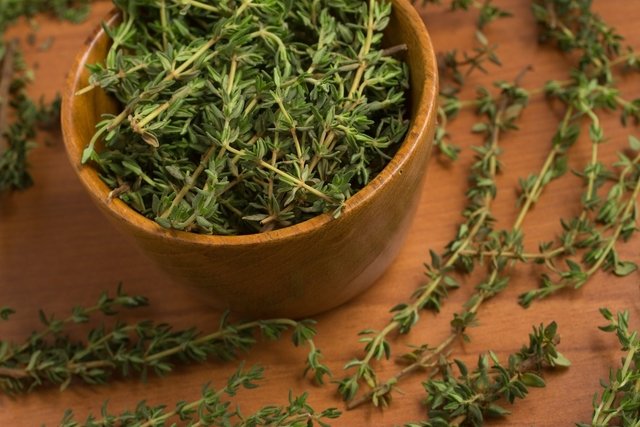Home remedies for vulvovaginitis, such as thyme and rosemary sitz bath, garlic tea with ginger or tea tree oil, for example, have antibacterial, antifungal and anti-inflammatory action, helping to alleviate symptoms of itching, irritation, redness, swelling and discharge.
Vulvovaginitis is an inflammation of the vulva and vagina that can occur in all women and at any age, and is generally caused by an infection with viruses, fungi or bacteria but can also arise due to hormonal changes, stress or allergies, causing symptoms. . See all the symptoms of vulvovaginitis.
Although they cannot replace medical treatment, home remedies are a good option to help alleviate the symptoms of vulvovaginitis and can be used to complement the treatment recommended by your doctor.
1. Thyme and rosemary sitz bath

The thyme and rosemary sitz bath is rich in antifungal and antibacterial substances such as thymol, carvacrol and camphor, which act to prevent the multiplication of fungi and bacteria, helping to reduce discomfort and inflammation in the intimate area, making it a great home remedy option. for vulvovaginitis.
Ingredients
- 700 mL of water;
- 2 teaspoons of dried thyme;
- 2 teaspoons of dried rosemary.
Preparation mode
Boil water with thyme and rosemary for 20 minutes. Strain the infusion, let it cool and take a sitz bath, placing the mixture in a basin or bathtub. Another option is to rinse the intimate area twice a day, until symptoms improve. Do not apply inside the vaginal canal.
This infusion should not be used by pregnant women.
2. Tea tree oil

Tea tree oil is rich in substances with antibacterial, antifungal and anti-inflammatory actions, such as terpinene and cineole, which help combat the symptoms of itching, redness, swelling and discharge common to different vaginal infections.
Ingredients
- 5 drops of tea tree essential oil;
- 2 tablespoons of coconut, sweet almond or olive oil.
Preparation mode
Mix the ingredients and apply to the external region of the vagina once a day for a maximum of 6 days in a row. Do not apply inside the vaginal canal.
Before applying tea tree oil to the vaginal region, you should check if you are allergic to this oil and, therefore, it is recommended to apply a drop of tea tree oil to the skin on the back of your hand. If allergy symptoms such as redness, itching, swelling or the formation of small blisters appear on your hand, you should wash your skin and not use tea tree oil as a home remedy for vulvovaginitis.
Tea tree oil should not be used by pregnant women.
3. Garlic and ginger tea

Garlic and ginger tea has antibacterial, antioxidant and anti-inflammatory properties due to allicin, present in garlic, and phenolic compounds in ginger such as gingerol, chogaol and zingerone, which act to alleviate the symptoms of vulvovaginitis such as itching, irritation and redness. , in addition to strengthening the immune system, allowing the body to recover faster from the infection.
Ingredients
- 3 cloves of garlic, peeled and cut in half;
- 1 cm of ginger root or ½ teaspoon of powdered ginger;
- 1 liter of water.
Preparation mode
Boil water with garlic. Remove from heat and add the ginger. Let it rest for 5 to 10 minutes. Strain and then drink up to 3 to 4 divided doses throughout the day.
Ginger should not be consumed by people using anticoagulants, and therefore should be removed from the tea in these cases.
4. Sitz bath with apple cider vinegar

Apple cider vinegar is another good option for a home remedy for vulvovaginitis because, as it is an acidic substance, it helps eliminate fungi and bacteria that cause vulvovaginitis, in addition to having anti-inflammatory action, relieving symptoms of itching, discharge, redness and swelling. .
Ingredients
- ½ cup of apple cider vinegar;
- 2 liters of water.
Preparation mode
Boil the water and add the apple cider vinegar. Wait for it to cool and place it in a basin or bathtub. Take a sitz bath for 20 minutes and then rinse.
Apple cider vinegar should always be diluted before coming into contact with the skin, as it is an acidic substance that can cause irritation.
This sitz bath should not be used by pregnant women.
5. Sitz bath with hydrogen peroxide

A sitz bath made with hydrogen peroxide helps reduce the symptoms of discharge and itching, and facilitates the treatment of vulvovaginitis, as it prevents the multiplication of bacteria that cause infection in the vulva and vagina.
Ingredients
- 3 tablespoons of hydrogen peroxide 10 volumes;
- 750 mL of boiling water.
Preparation mode
Add hydrogen peroxide to boiling water and mix. Let it cool and take a sitz bath, placing the mixture in a basin or bathtub. Another option is to rinse the external region of the vagina once a day for a maximum of 1 week. Do not apply inside the vaginal canal.
Bibliography
- BOGAVAC, Mirjana A.; et al. Antimicrobial Potential of Rosmarinus officinalis Commercial Essential Oil in the Treatment of Vaginal Infections in Pregnant Women . Natural Product Communications. 12. 1; 127-130, 2017
- SAEIDI, Saeide; et al. Effects of Rosmarinus Officinalis Plant Extract on Trichomonas Vaginalis Parasites and Candida albicans under Laboratory Conditions: An Experimental Study. Gene Cell Tissue. 6. 3; e92867, 2019
- OZEN, Betul; BASER, Muruvet. Vaginal Candidiasis Infection Treated Using Apple Cider Vinegar: A Case Report. Altern Ther Health Med. 23. 7; AT5751, 2017
- CARDONE, A.; et al. Utilisation of hydrogen peroxide in the treatment of recurrent bacterial vaginosis. Minerva Gynecologist. 55. 6; 483-492, 2003
- SHEIDAEI, Sedigheh; et al. Herbal Medicine and Vaginal Candidiasis in Iran: A Review. Evidence Based Care Journal. 7. 2; 71-77, 2017
- BAHADORAN, P.; ROKNI, F.K.; FAHAMI, F. Investigating the therapeutic effect of vaginal cream containing garlic and thyme compared to clotrimazole cream for the treatment of mycotic vaginitis. Iran J Nurs Midwifery Res. 15. 1; 343–349, 2010
- HAMMER, K. A.; CARSON, C. F.; RILEY, T. V . In Vitro Susceptibilities of Lactobacilli and Organisms Associated with Bacterial Vaginosis to Melaleuca alternifolia (Tea Tree) Oil. Antimicrob Agents Chemother. 43. 1; 196, 1999
- PALMEIRA-DE-OLIVEIRA, Rita; PALMEIRA-DE-OLIVEIRA, Ana; MARTINEZ-DE-OLIVEIRA, José. New strategies for local treatment of vaginal infections. Adv Drug Deliv Rev. 92. 105-122, 2015
- 351-358. Common Complementary and Alternative Therapies for Yeast Vaginitis and Bacterial Vaginosis: A Systematic Review. Obstetrical and Gynecological Survey. 58. 5; VAN KESSEL, Katherine; et al, 2003

Sign up for our newsletter and stay up to date with exclusive news
that can transform your routine!
Warning: Undefined array key "title" in /home/storelat/public_html/wp-content/plugins/link-whisper-premium/templates/frontend/related-posts.php on line 12
Warning: Undefined array key "title_tag" in /home/storelat/public_html/wp-content/plugins/link-whisper-premium/templates/frontend/related-posts.php on line 13



